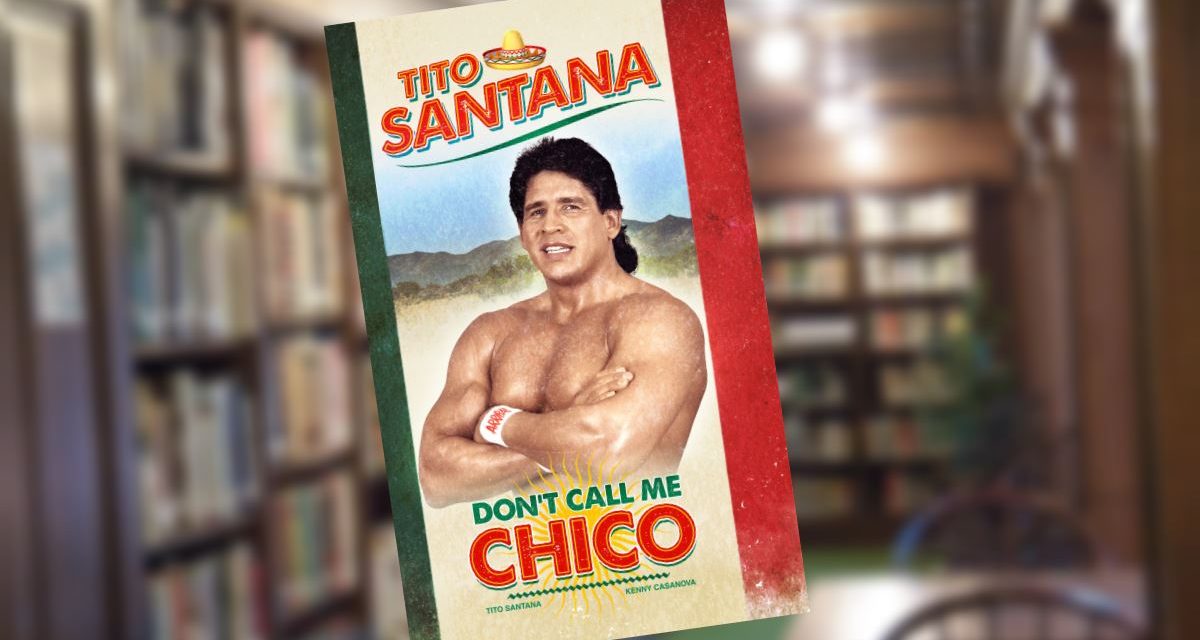Tito Santana is one of only a few wrestlers who can claim that they’ve worked as a babyface (aka a good guy) for their entire pro wrestling career. Often referred to as “one of the nicest guys in wrestling,” Santana is now sharing his story and shedding parts of his squeaky-clean image in his autobiography, Don’t Call Me Chico, out now from Walking on Hot Waffles Publishers.
The book is ghostwritten by Kenny Casanova, who is just one of the many pro wrestling fans who proudly cheered on Santana. “I was a big Tito mark!” admitted Casanova in a phone interview with SlamWrestling.net. “He (Santana) was like the more attainable hero as a kid that I could relate to because you saw him more often than (the heavyweight champion). You would have to go out of your way to see a Hulk Hogan match. There was no (WWE) Network. There was no YouTube. But he (Santana) was on (television) quite a bit.” (EDITOR’S NOTE: SlamWrestling.net did reach out to Santana for this story, but he did not respond to our interview requests).
Although he has ghostwritten other pro wrestling autobiographies, Casanova says that Santana was one of the first wrestlers he thought about doing a book for, so finally getting the opportunity has “been a big deal.” And while some readers may be shocked at the book’s title, Casanova assures them that Santana approved it and “liked it right away.” Fans may recall that Santana was referred to as “Chico” by Jesse “The Body” Ventura during his time as a commentator for WWE. Santana addresses the situation in book’s 14th chapter:
“It’s easy for me to understand why such comments are viewed as discriminatory, but let me be very clear in saying that Jesse is not a racist person at all. He never said those things maliciously toward me. He was simply playing a role in (a) time where race was more acceptable in comedy than it is today, acting in a way that would help me to get over with the fans. Jesse made me money, and did a great job at it, too.”
Casanova says he also took on the project because he admitted he was disappointed in Santana’s first book, 2008’s Tito Santana’s Tales from the WWF with Tom Caiazzo. To him, the “kayfabe type book” didn’t capture the real Santana and instead portrayed him as a “bitter veteran.” Casanova says he strived to show the gentlemanly and humorous side of Santana, while still getting “the behind the scenes stuff that fans want.” He also feels the book’s message of how Santana, while never achieving the levels of fame and acclaim of some of his peers, still “did really well for himself through dedication, loyalty and working hard for (the WWE)” will resonate with readers.

Kenny Casanova.
Don’t Call Me Chico is definitely not bitter, nor is it boring. (None of Casanova’s books are ever boring!) Santana, born Merced Solis, is actually quite jovial throughout the book and definitely has a compelling story to tell even before he ever steps foot into a wrestling ring. This reader had no idea that Santana spent his early childhood days in Mission, Texas, living “in a small two-bedroom house given to us by my grandparents” without running water and helping his family make a meager living as migrant farm workers.
“The harvesting routine for my family was always the same,” shared Santana in the book’s first chapter. “First, we went to Milford, Illinois to pick asparagus; from there we moved to Wisconsin or Michigan to pick cherries or strawberries. Then next, in early September, we would move to Indiana to pick tomatoes and we stayed there until about the middle of October or until the frost ruined the tomato crop. During the Christmas holidays, we would pick oranges, grapefruits or carrots. When March came around, we would pick onions after school and on weekends.”
Santana also addresses growing up as a minority and experiencing prejudice:
“I knew that I was different from a lot of the folks from back around my real home,” reflected Santana in the book’s first chapter. “I had a lot of little different things that (happened to) me at school. For one, I wasn’t there all the time. I think because of that, sometimes the other students who did not come from similar like families would look at me like I was different. This ‘look’ is something I can’t explain to someone who has never seen it before, only other than saying it felt like they saw you as being inferior. Sadly, I also sometimes would get the same second-rate citizen look from some of the teachers.”
The book amply covers Santana’s journey into the ring, although he admits he “never wanted to be a pro wrestler.” He actually dreamed of playing football until severely spraining his Achilles tendon. There’s a plethora of details within the book’s almost 400 pages, from Santana’s early days as a referee to training as a wrestler in Florida to appearing on the WWE’s first nine WrestleManias. Just as a side, as an unabashed fan of 1985’s The Wrestling Album, I was quite excited to see that there are a few pages dedicated to stories from the creation of this musical masterpiece. I can’t be the only one who feels this way, right?
Along with the replay of Santana’s career, readers are also treated to some fun trivia along the way. I don’t want to give everything away, but did you know that:
- Santana initially wrestled under the name, Richard Blood, which is the real name of Hall of Famer Ricky Steamboat.
- The late Dino Bravo recommended that Santana use “¡Arriba!” to end his promos. (Santana also utilizes his catch phrase after several jokes in this book!)
- Santana has a win over The Undertaker! (“I will say this, however, Tito Santana has an undefeated streak against The Undertaker! ¡Arriba!”)
- Santana is technically a former ECW Heavyweight Champion.
- Santana actually suggested he be the one to turn heel (the bad guy) instead of Rick Martel when their tag team, Strike Force, was broken up.
So, it must be asked, if Santana had been chosen to turn heel instead of Martel, would he have been able to pull it off?
“I think he (Santana) could have pulled it off because he was in it (pro wrestling) for so long,” offered Casanova. “And he used to drive with all the heels. He used to like to ride with Demolition and guys like that, so I’m sure he picked up all kinds of ideas on how he would have done it.”
It must be noted that sometimes having a lot of details in a book is not always a positive thing. There are some odd and difficult transitions in the book making for a somewhat scattered read. The book could also do with a more thorough proofreading, which Casanova acknowledged in the interview. And while there are plenty of behind the curtain wrestling stories, as promised by Casanova and which many pro wrestling fans crave, some of the stories in the book come off as out of place or even as filler as they don’t always involve Santana. But at the same time, it is evident that Casanova has a great passion for pro wrestling, wrestlers and pro wrestling books. It’s also admirable that he’s a self-professed “one-man-show” doing the writing, publishing and marketing for his own books.
While this book was released before the #SpeakingOut movement, where females and males have come forward to share their stories of abuse and harassment in the pro wrestling industry, it’s difficult to condone a section of the book entitled, “RAT TRAPS” and other similar content throughout. ”Ring rats” is the unfortunate moniker given to women that are essentially pro wrestling groupies. While I realize, salacious stories sell books and that’s what many readers are looking for, the inclusion of these stories comes off as gratuitous and not necessary especially since Santana pointed out in the book, “Now at this point, I was happily married and did not partake in such carnal temptations. But there were many of the boys who did! (Shame shame!)”
And I know there will be readers who will angrily disagree with me on this and some might feel I’m being too harsh or sensitive. And yes, I am well aware that Santana is not the only pro wrestler, nor famous person, to include this kind of material in their books. I will also admit that I did thoroughly enjoy the majority of this book. But at the same time, we all must acknowledge the #SpeakingOut movement and recognize that chalking up stories like this to the old adage of “boys will be boys” downplays the fact that a lot of women have been treated really badly by pro wrestlers and some of this behavior is in fact criminal. Even Santana concludes at the end of the section that “if guys today did stuff like some of the boys did back then, they likely wouldn’t be in wrestling. They likely would be in jail!”
RELATED LINKS:

